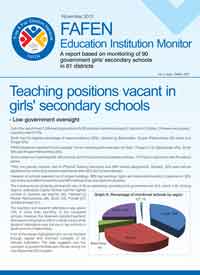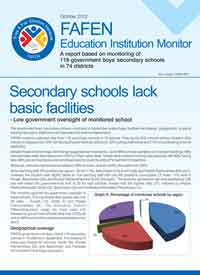- Low government oversight
- FAFEN Education Institution Monitor: A report based on monitoring of 90 government girls’ secondary schools in 61 districts
Out of the sanctioned 2,246 teaching positions for 90 schools monitored across 61 districts in October, 218 were unoccupied – a vacancy rate of 10%. Sindh had the highest percentage of vacant positions (22%), followed by Balochistan, Khyber Pakhtunkhwa (8% each) and Punjab (5%). FAFEN observers reported that on average 7% non-teaching slots were also not filled – Punjab (11%), Balochistan (8%), Sindh (5%) and Khyber Pakhtunkhwa (5%).
As for certain non-teaching staff, 20% schools did not have services of sanitary workers, 17% had no watchmen with 2% without peons. Thirty one percent schools had no Physical Training Instructors and 38% lacked playgrounds. Similarly, 33% were without apparatus for conducting science experiments while 42% did not have libraries.
However, all schools operated out of proper buildings; 99% had windows, lights and black/white boards in classrooms; 93% had chairs and tables for teachers and 90% had benches and desks for students. The monitors found students-per-teacher ratio of 30 as satisfactory and below the government-set limit, which is 50. Among regions, Islamabad Capital Territory had the highest number of students per teacher (42), followed by Khyber Pakhtunkhwa (39), Sindh (33), Punjab (27) and Balochistan (21).
The teachers’ and students’ attendance was above 75% in more than four-fifths of the monitored schools. However, the observers reported teachers’ attendance being below 50% in a Sindh school while students’ attendance was this low in two schools in Sindh and one in Balochistan. A lot of the issues highlighted here can be resolved through regular and informed oversight of the relevant authorities. The data suggests very low oversight of government/elected officials during the July-September 2012 quarter.
Only 36 visits were made to the monitored schools – 18 by the Executive District Officers (EDOs) followed by some other government officials (13), elected representatives (3) and Members Provincial Assemblies (2).
Schools in Punjab had the most such visits (19), followed by Khyber Pakhtunkhwa (9), Sindh (7) and Balochistan (1).
To download complete report, click here



